Overview
The seven key benefits of ECG AI readers for enhanced cardiac diagnostics encompass:
- Improved signal clarity
- Rapid data processing
- Increased diagnostic accuracy
These advantages collectively contribute to better patient outcomes. This article elaborates on how advanced AI algorithms in systems like MaxYield™ automate ECG analysis, effectively reduce operational costs, and facilitate timely medical interventions. Ultimately, these innovations are transforming cardiac care.
Introduction
The landscape of cardiac diagnostics is rapidly evolving, driven by the integration of artificial intelligence into electrocardiogram (ECG) analysis. This technological advancement not only enhances diagnostic accuracy but also significantly improves clinical workflow efficiency. As a result, healthcare professionals can dedicate more time to patient care. However, a critical question arises: how can the adoption of ECG AI readers address the ongoing challenges of noise, signal clarity, and timely intervention in cardiac care? By exploring the seven key benefits of these advanced systems, we can uncover their transformative potential in reshaping the future of cardiac diagnostics and improving patient outcomes.
Neural Cloud Solutions' MaxYield™: Transforming ECG Analysis with Advanced AI Technology
The challenges in ECG analysis often stem from noise and signal artifacts, which can obscure the true cardiac signals. 'Neural Cloud Solutions' addresses these challenges with its MaxYield™ platform, revolutionizing ECG analysis through an ECG AI reader that employs advanced AI algorithms to automate the processing of ECG signals. This innovative technology significantly enhances the clarity of ECG data, empowering healthcare professionals to make informed decisions based on precise cardiac insights.
MaxYield™ is capable of processing over 200,000 heartbeats in under five minutes, delivering detailed beat-by-beat analysis. It effectively isolates and labels critical features such as P-waves, QRS complexes, and T-wave intervals. This automation not only accelerates the analysis process but also markedly improves the quality of ECG data, establishing it as an indispensable tool for clinicians and researchers alike.
Moreover, the system's continuous learning model ensures that its algorithms develop over time, further enhancing precision and efficiency in ECG analysis. This is essential for and resource distribution in various clinical settings. Targeting ECG signals in adults aged 18 and older, the MaxYield™ system is designed to meet the needs of a diverse clinical audience.
As noted by healthcare professionals, the integration of the ECG AI reader in ECG analysis not only enhances signal clarity but also supports consistent clinical decision-making. By ensuring that true ECG signals are accurately interpreted, MaxYield™ stands out as a vital resource in the healthcare landscape.

AI-Powered ECG Readers: Enhancing Diagnostic Accuracy in Cardiac Care
The ECG AI reader, powered by artificial intelligence, is transforming diagnostic accuracy in cardiac care by utilizing advanced machine learning algorithms to identify subtle abnormalities that human interpreters may miss. These systems significantly improve the detection of arrhythmias, ST-segment changes, and QT prolongation, enabling .
A study involving 628 tests revealed a strong correlation between red results and referrals to cardiology clinics, underscoring the effectiveness of AI in early diagnosis and treatment. Moreover, AI tools demonstrate a positive predictive accuracy of 80% and a negative predictive accuracy of 90.4% in identifying underlying cardiovascular diseases, as shown in research led by Dr. Simon Rudland. This highlights their reliability in clinical environments.
As these technologies advance, they are set to democratize access to high-quality cardiovascular diagnostics and tackle health equity, ultimately enhancing patient outcomes across diverse populations. The system developed by Neural Cloud Solutions exemplifies these advancements by utilizing an ECG AI reader to automate ECG analysis and clarify cardiac signals.
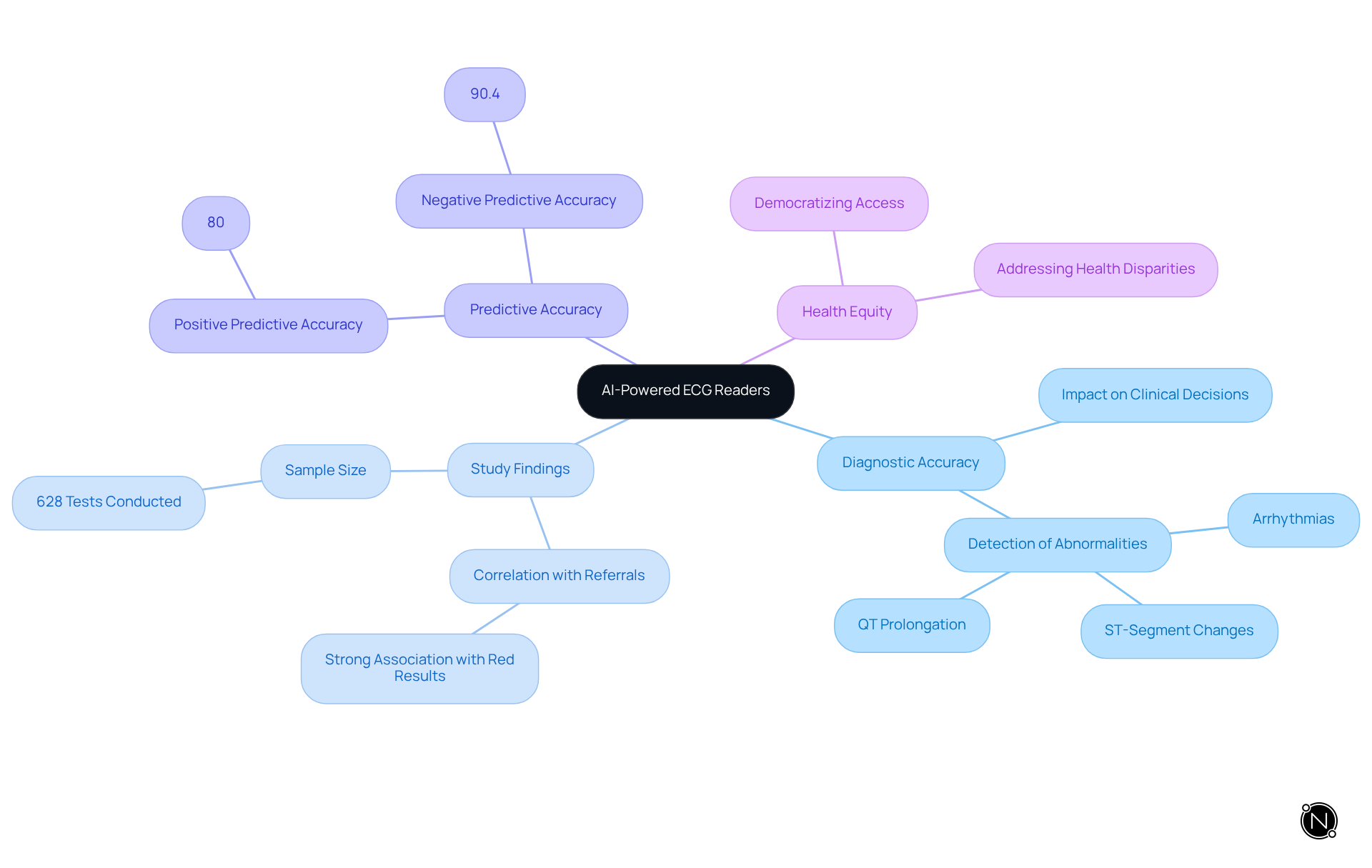
Rapid Data Processing: How ECG AI Readers Improve Clinical Decision-Making
The use of the ECG AI reader is transforming clinical decision-making by leveraging rapid data processing capabilities, which deliver actionable insights almost instantaneously. This system exemplifies innovation, efficiently in under five minutes. Such efficiency is vital in emergency situations, where timely diagnosis and treatment can significantly influence patient outcomes, especially for conditions like acute coronary syndromes.
Statistics indicate that the AI-ECG group reduced the time from ECG acquisition to arrival in the cath lab to an average of 43.3 minutes, compared to 52.3 minutes for usual care, with a statistically significant difference (p = 0.003). This underscores the essential role of speed in cardiac care.
Experts, including Dr. Chin-Sheng Lin, emphasize that the ECG AI reader's ability to quickly interpret ECG data not only enhances diagnostic accuracy but also optimizes resource allocation, ultimately improving patient care and outcomes. Furthermore, the system's ongoing learning model ensures that its algorithms evolve over time, enhancing both precision and productivity.
The AI-ECG exhibits a positive predictive value of 88.0% and a negative predictive value of 99.9%, further highlighting its effectiveness in enhancing clinical outcomes.
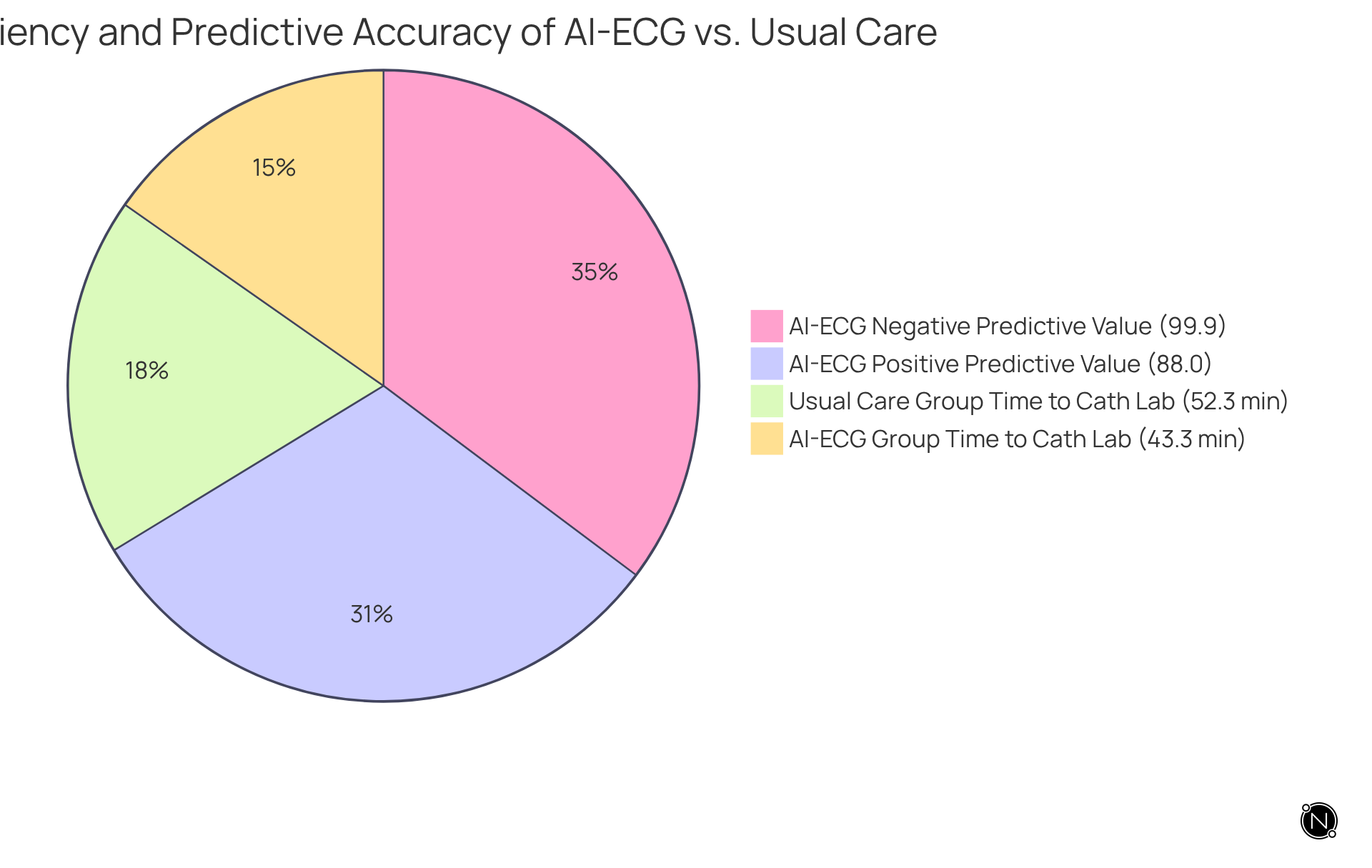
Seamless Integration: ECG AI Readers and Existing Healthcare Systems
The ECG AI reader is designed for seamless integration with existing medical systems, including electronic health records (EHRs) and various diagnostic tools. This compatibility enables a smooth transition to , significantly minimizing disruptions in clinical practice.
For example, the MaxYield™ platform can be integrated effortlessly into diverse clinical settings, allowing medical professionals to leverage AI capabilities without extensive system overhauls. Such integration not only streamlines processes but also enhances the overall efficiency of cardiac diagnostics, empowering clinicians to concentrate on patient care rather than administrative tasks.
IT professionals in the medical field highlight that ensuring EHR compatibility with AI tools is essential for maximizing the advantages of these advanced technologies in clinical environments. Moreover, with the recent establishment of a national payment rate for the ECG AI reader, effective January 1, 2025, the integration of AI into healthcare systems is more timely than ever.
The system's ability to process over 200,000 heartbeats in less than five minutes showcases its effectiveness, while its design addresses challenges like noise and signal artifacts that can obscure genuine ECG signals.
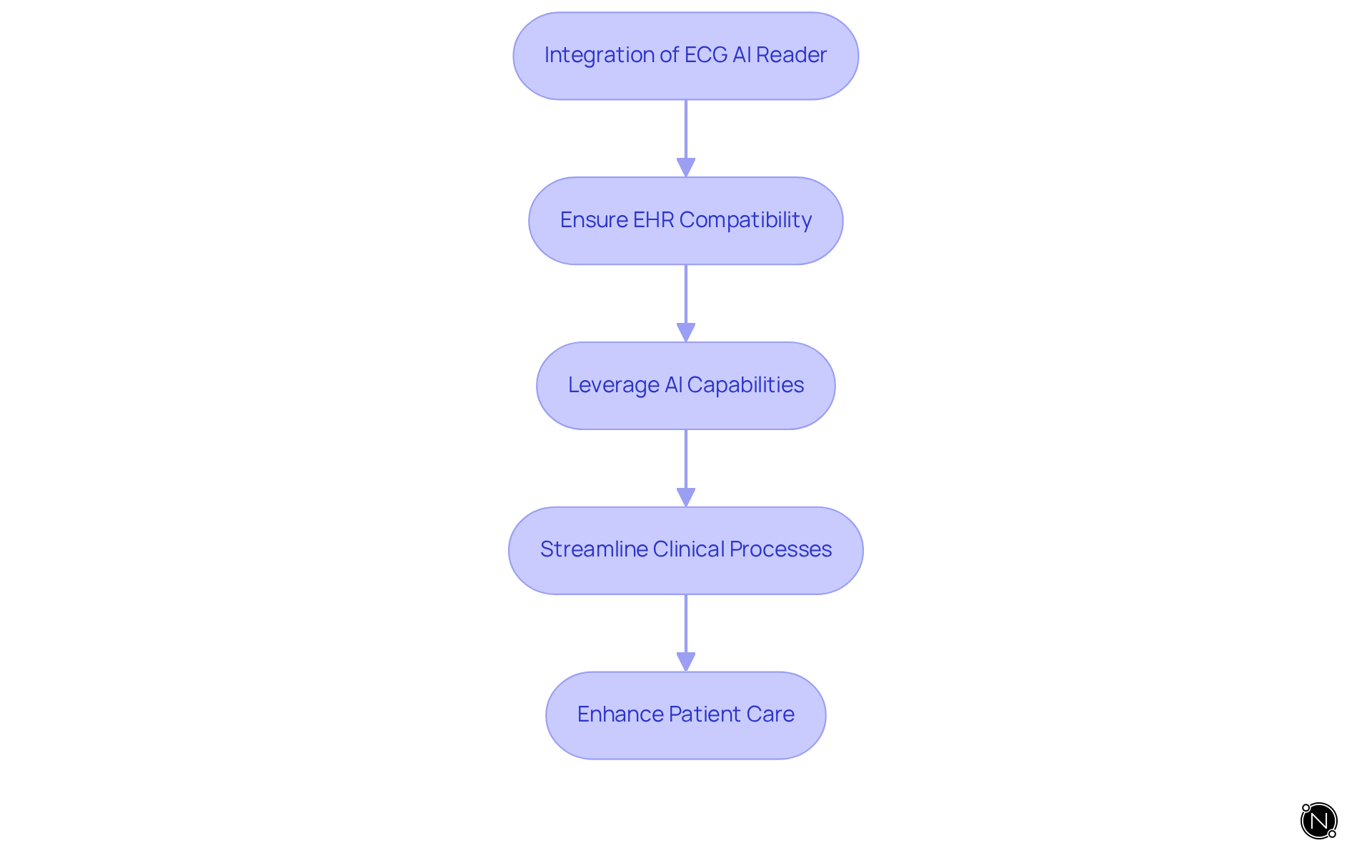
Noise Reduction: The Role of AI in Enhancing ECG Signal Clarity
AI significantly enhances ECG signal clarity through advanced noise reduction techniques. The system utilizes exclusive algorithms designed to eliminate various noise categories, including baseline drift and muscle interferences. This leads to , which are essential for accurate interpretation. The system can process over 200,000 heartbeats in less than five minutes, showcasing its effectiveness in providing prompt cardiac insights.
Noise can obscure critical cardiac events, potentially resulting in misdiagnosis or delayed treatment. Cardiologists emphasize that improved signal clarity is vital for effective diagnostics, as it allows for the precise identification of cardiac anomalies. As one cardiologist noted, 'The clarity of ECG signals is paramount; any noise can lead to significant misinterpretations.'
Recent advancements in AI technology, particularly with the ecg ai reader, demonstrate a commitment to addressing these challenges, ultimately enhancing the quality of cardiac care. Furthermore, the system automates the labeling of ECG waveforms, enabling medical professionals to focus on high-level decision-making rather than manual tasks.
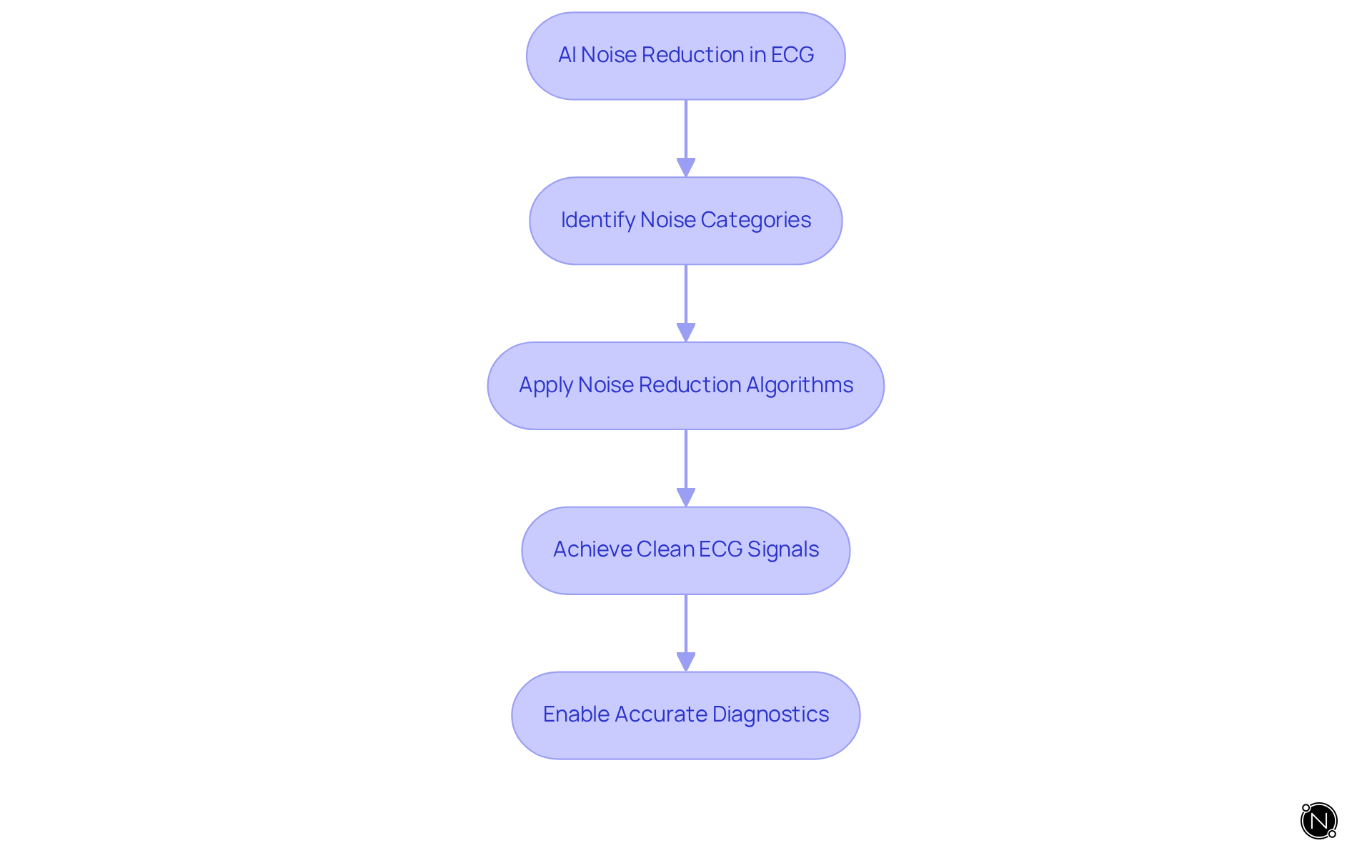
Scalability of ECG AI Readers: Adapting to Diverse Clinical Environments
The ECG AI reader addresses significant challenges in ECG analysis by offering a scalable solution suitable for diverse clinical environments, from small outpatient clinics to large hospitals. The MaxYield™ platform exemplifies this adaptability, efficiently processing ECG data from various devices, including wearables and Holter monitors. This capability allows healthcare providers to leverage the tailored to their operational contexts, regardless of patient volume or workload.
Dr. Paul Friedman emphasizes that integrating AI tools in clinics can greatly enhance the screening process, facilitating timely diagnoses and improving patient outcomes. Notably, the ECG AI reader can process over 200,000 heartbeats in under five minutes, showcasing its impressive efficiency. Additionally, the continuous learning model of MaxYield™ ensures that its algorithms evolve, maintaining high accuracy and efficiency even as clinical demands fluctuate.
This adaptability not only streamlines workflows but also empowers healthcare professionals to concentrate on critical decision-making, ultimately enhancing the quality of cardiac diagnostics. Furthermore, the ECG AI reader effectively addresses challenges posed by noise and signal artifacts, reinforcing its reliability as a solution in ECG analysis.
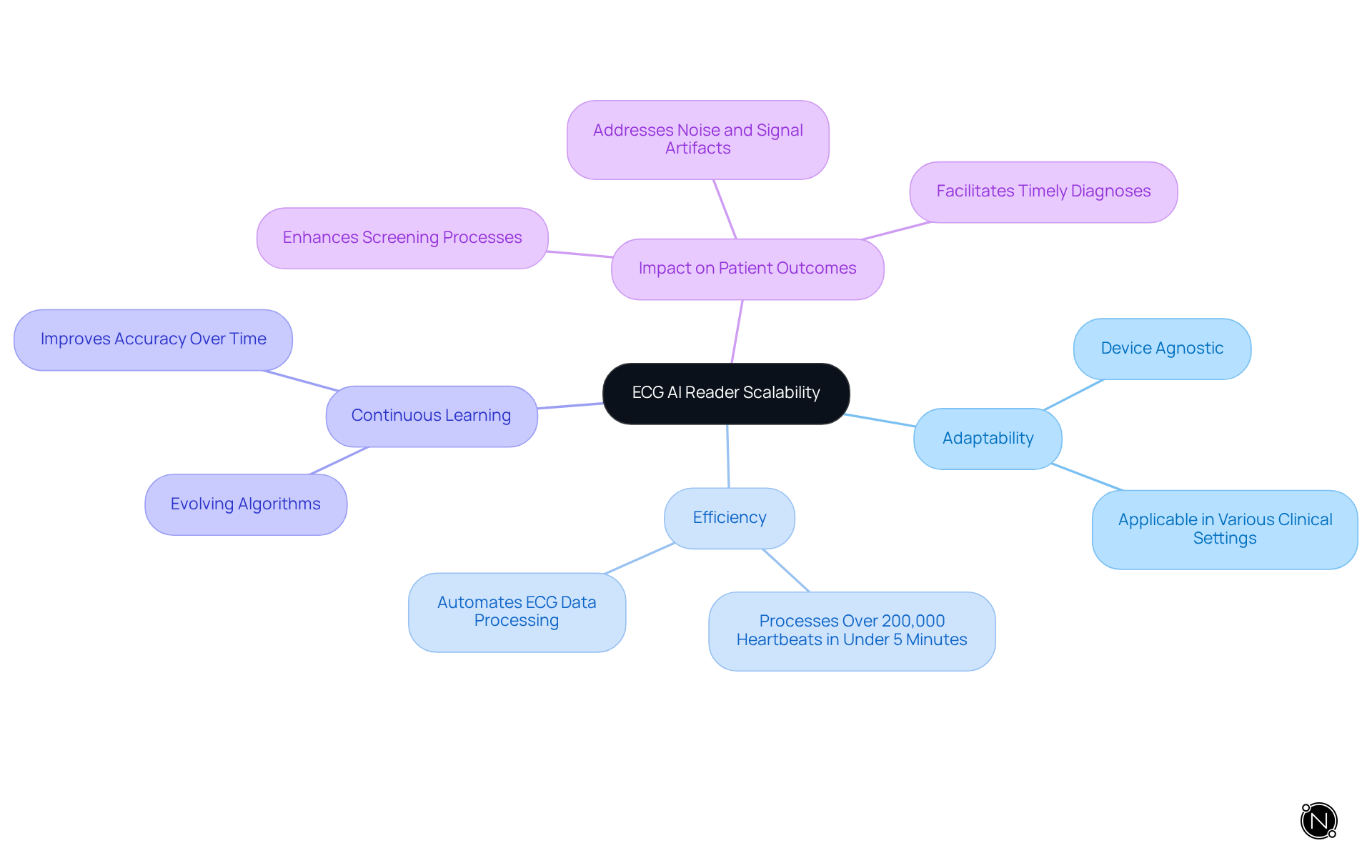
Continuous Learning: How AI Algorithms Evolve for Better ECG Diagnostics
A significant challenge in ECG analysis is the need for continuous learning and improvement. The MaxYield™ platform addresses this through its advanced algorithms, which are designed to adapt based on new data inputs and clinical feedback. This ongoing evolution enhances the accuracy and reliability of ECG diagnostics, enabling medical providers to leverage the without overhauling their existing systems. For example, the EchoNext algorithm has demonstrated a positive predictive value of 74%, underscoring the effectiveness of AI in enhancing diagnostic precision.
As these algorithms process vast amounts of ECG data, they refine their predictive capabilities, ultimately improving diagnostic accuracy. This dynamic learning process not only tackles the complexities of cardiac conditions but also empowers clinicians to make informed decisions based on the most current insights available. As Salah Al-Zaiti, Ph.D., noted, "Our model helps address this major challenge by improving risk assessment so that patients can get appropriate care without delay."
The integration of evolving AI technology in cardiac diagnostics, particularly through the use of an ECG AI reader, represents a transformative shift in how medical professionals approach ECG analysis. It ensures that they remain at the forefront of patient care. However, it is crucial to recognize the challenges in clinical implementation, such as the necessity for robust IT infrastructure and trained personnel. Addressing these challenges is essential to fully realize the potential of the ECG AI reader in ECG diagnostics.
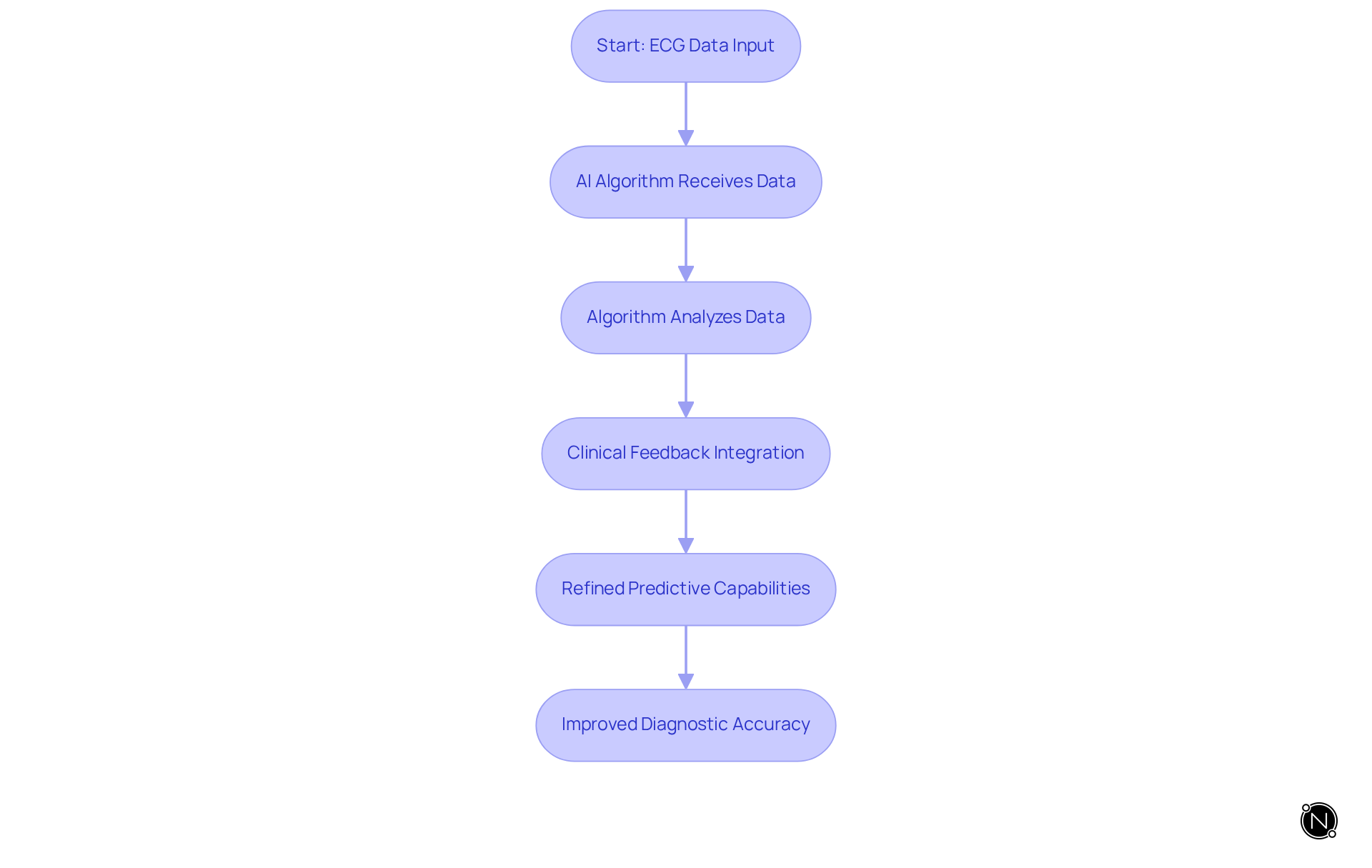
Cost Efficiency: Reducing Operational Expenses with ECG AI Readers
The use of an ECG AI reader is essential in minimizing operational expenses by automating labor-intensive tasks and enhancing workflow efficiency. This platform exemplifies this by significantly decreasing the time medical professionals dedicate to using the ECG AI reader. Such automation enables clinicians to focus on higher-level decision-making, which not only lowers labor costs but also enhances the overall productivity of clinical teams. Consequently, medical providers can establish a more cost-effective operational model.
Moreover, AI-driven solutions, especially AI assistants in hospital administration, have demonstrated the potential to save hospitals an estimated 38-47% of administrative time, which could translate into annual savings exceeding $13 million. By streamlining processes and minimizing inefficiencies, AI technologies like MaxYield™ are vital for optimizing resource allocation and improving financial performance within medical settings.
Nonetheless, it is crucial to recognize that integrating AI solutions may pose challenges, such as compatibility with existing systems and the necessity for staff training. As noted by medical experts, the adoption of AI-driven solutions can facilitate these transitions, ultimately leading to a more adaptable and patient-focused service delivery.
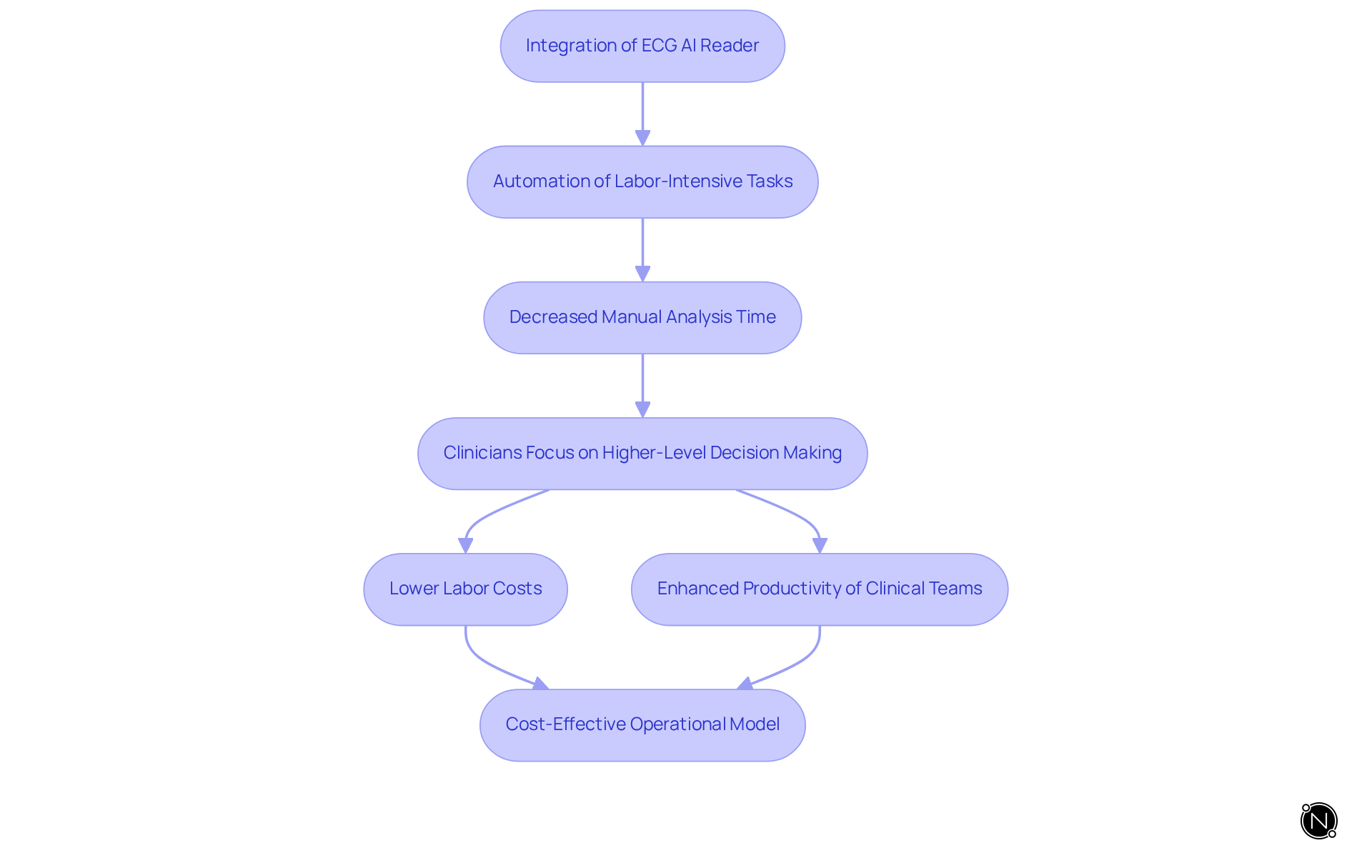
User Adoption: Overcoming Challenges in Implementing ECG AI Technology
The integration of the ECG AI reader into clinical practice presents several challenges that can hinder user adoption. Healthcare professionals often express hesitance towards new technologies, primarily due to concerns regarding reliability, usability, and the necessity for adequate training. A recent study indicated that hospitals with integrated salary models tend to have higher rates of AI adoption, suggesting that organizational support plays a crucial role in overcoming these barriers.
To enable smoother adoption, it is essential to offer and continuous support customized to the needs of medical providers. Engaging clinicians in the implementation process not only fosters a sense of ownership but also helps demonstrate the tangible benefits of the ECG AI reader technologies. For instance, Martha Grogan, a leading cardiologist, emphasizes that addressing research gaps and implementation barriers is crucial for realizing the full potential of these technologies.
Moreover, addressing the barriers to AI adoption requires a multifaceted approach. Recent news suggests that advancements in algorithmic transparency and data governance are crucial for establishing trust among medical professionals. By focusing on these areas, organizations can enhance the integration of AI tools into clinical workflows, ultimately improving patient outcomes and streamlining diagnostic processes. As AI progresses, the dedication to training and support will be crucial in guaranteeing that medical professionals can utilize these technologies to their fullest potential.

Improving Patient Outcomes: The Transformative Impact of ECG AI Readers
The transformative impact of the ECG AI reader extends beyond operational efficiency and cost savings; it fundamentally enhances patient outcomes. These advanced technologies, such as the ECG AI reader, improve diagnostic precision and significantly decrease analysis duration, enabling medical professionals to make prompt and informed decisions. This capability is particularly crucial in emergency scenarios, where rapid diagnosis can dramatically affect patient survival and recovery rates.
For example, a study involving nearly 16,000 patients showed that the ECG AI reader systems enabled by AI can reduce all-cause mortality by 17% within 90 days for high-risk patients, underscoring the importance of timely intervention. As Robert Herman, MD, co-founder and chief medical officer of Powerful Medical, stated, "We are able to identify two times more of these patients that are currently missed using just the initial ECG recorded when the patient is hospitalized."
With the continuous advancement of AI technology, the integration of the ECG AI reader into cardiac care is set to expand, consistently and reshaping the future of healthcare. The MaxYield™ platform plays a crucial role in this evolution, automating ECG waveform labeling and enhancing signal clarity. This platform addresses the challenges in ECG analysis by streamlining processes and improving accuracy, ultimately benefiting healthcare professionals and their patients.

Conclusion
The integration of ECG AI readers signifies a remarkable leap forward in cardiac diagnostics, fundamentally altering the approach healthcare professionals take toward ECG analysis. By harnessing advanced AI technology, these systems improve the clarity and accuracy of cardiac signals. This enhancement facilitates timely and informed clinical decisions, ultimately leading to better patient outcomes.
Key benefits of ECG AI readers include:
- Rapid data processing, which enables swift analysis of heartbeats
- Seamless integration with existing healthcare systems
- Continuous learning capabilities that enhance diagnostic precision over time
- The ability to reduce noise and signal artifacts, ensuring accurate identification of critical cardiac events, significantly decreasing the risk of misdiagnosis
As the healthcare industry evolves, the adoption of AI technologies like ECG AI readers becomes essential for optimizing patient care. By addressing challenges related to user adoption and emphasizing training and support, medical professionals can fully leverage the potential of these innovative tools. The transformative effect of AI in cardiac diagnostics not only streamlines workflows and reduces operational costs but also leads to improved patient outcomes. Therefore, it is crucial for healthcare providers to prioritize the integration of such technologies into their practices.
Frequently Asked Questions
What challenges does MaxYield™ address in ECG analysis?
MaxYield™ addresses challenges in ECG analysis such as noise and signal artifacts that can obscure true cardiac signals, enhancing clarity and enabling informed decision-making.
How does MaxYield™ improve the ECG analysis process?
MaxYield™ automates the processing of ECG signals using advanced AI algorithms, allowing it to process over 200,000 heartbeats in under five minutes and deliver detailed beat-by-beat analysis.
What features can MaxYield™ isolate and label?
MaxYield™ can isolate and label critical features such as P-waves, QRS complexes, and T-wave intervals, significantly improving the quality of ECG data.
How does the continuous learning model of MaxYield™ benefit ECG analysis?
The continuous learning model allows MaxYield™'s algorithms to develop over time, enhancing precision and efficiency in ECG analysis, which optimizes diagnostic yield and resource distribution.
What is the target audience for the MaxYield™ system?
The MaxYield™ system targets ECG signals in adults aged 18 and older, catering to a diverse clinical audience.
How does the ECG AI reader enhance diagnostic accuracy in cardiac care?
The ECG AI reader utilizes advanced machine learning algorithms to identify subtle abnormalities, significantly improving the detection of arrhythmias, ST-segment changes, and QT prolongation.
What were the findings of the study involving ECG AI readers?
A study revealed a strong correlation between red results and referrals to cardiology clinics, demonstrating the effectiveness of AI in early diagnosis and treatment, with a positive predictive accuracy of 80% and a negative predictive accuracy of 90.4%.
How does rapid data processing impact clinical decision-making?
Rapid data processing allows the ECG AI reader to deliver actionable insights almost instantaneously, which is crucial in emergency situations, improving timely diagnosis and treatment.
What statistics highlight the efficiency of the AI-ECG group in clinical settings?
The AI-ECG group reduced the time from ECG acquisition to arrival in the cath lab to an average of 43.3 minutes, compared to 52.3 minutes for usual care, indicating a significant improvement in speed.
What are the predictive values of the AI-ECG system?
The AI-ECG system exhibits a positive predictive value of 88.0% and a negative predictive value of 99.9%, underscoring its effectiveness in enhancing clinical outcomes.






